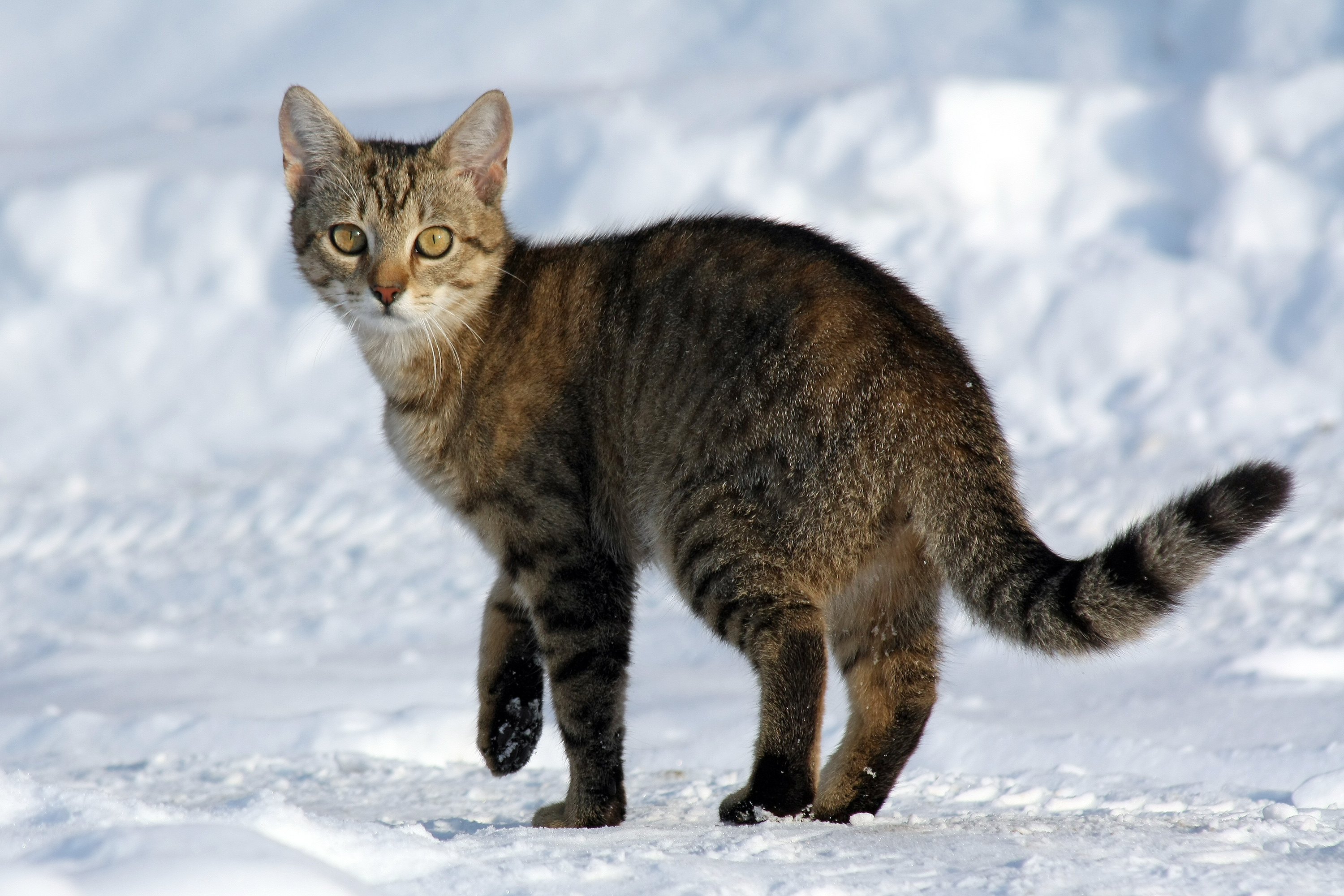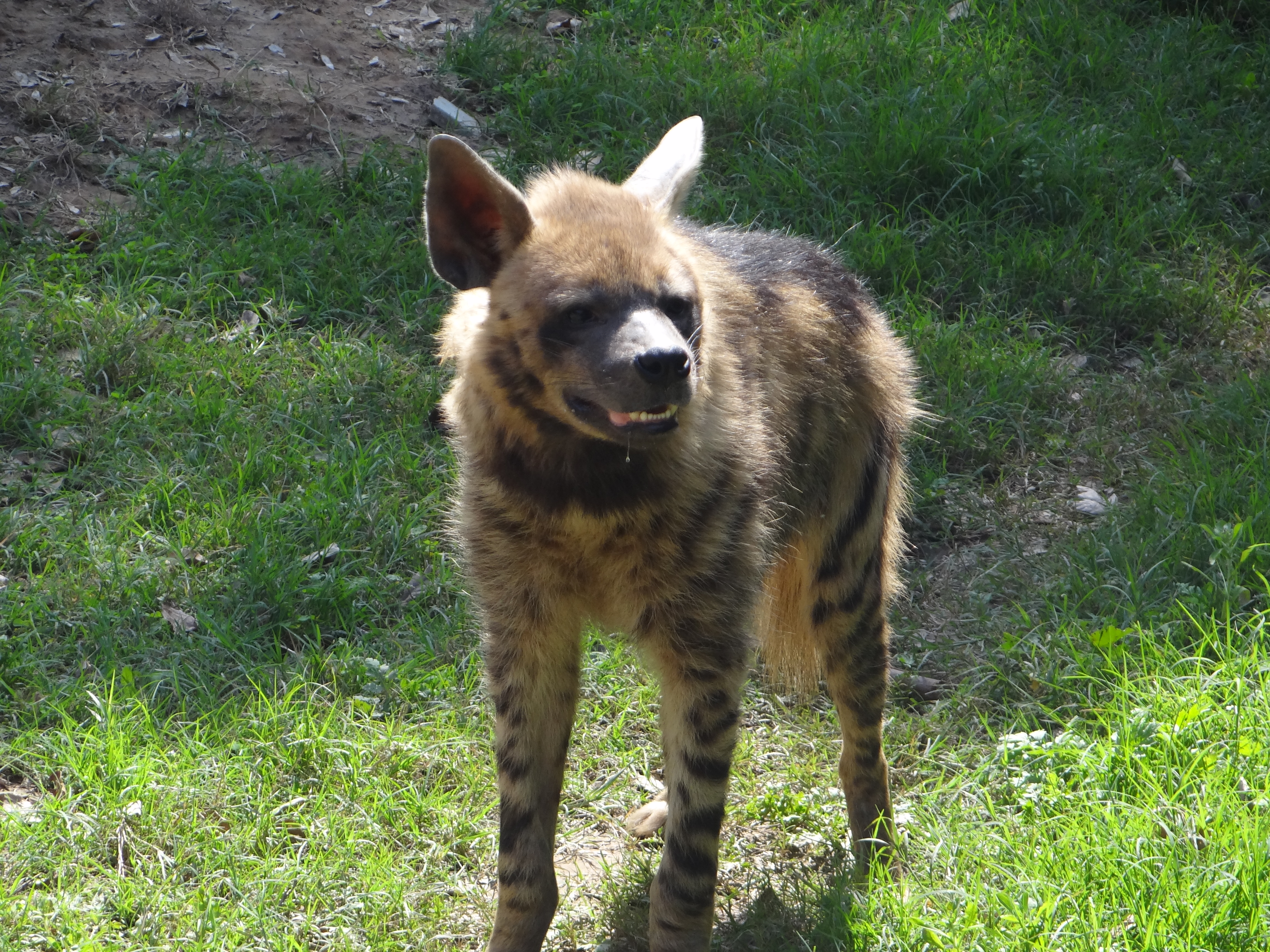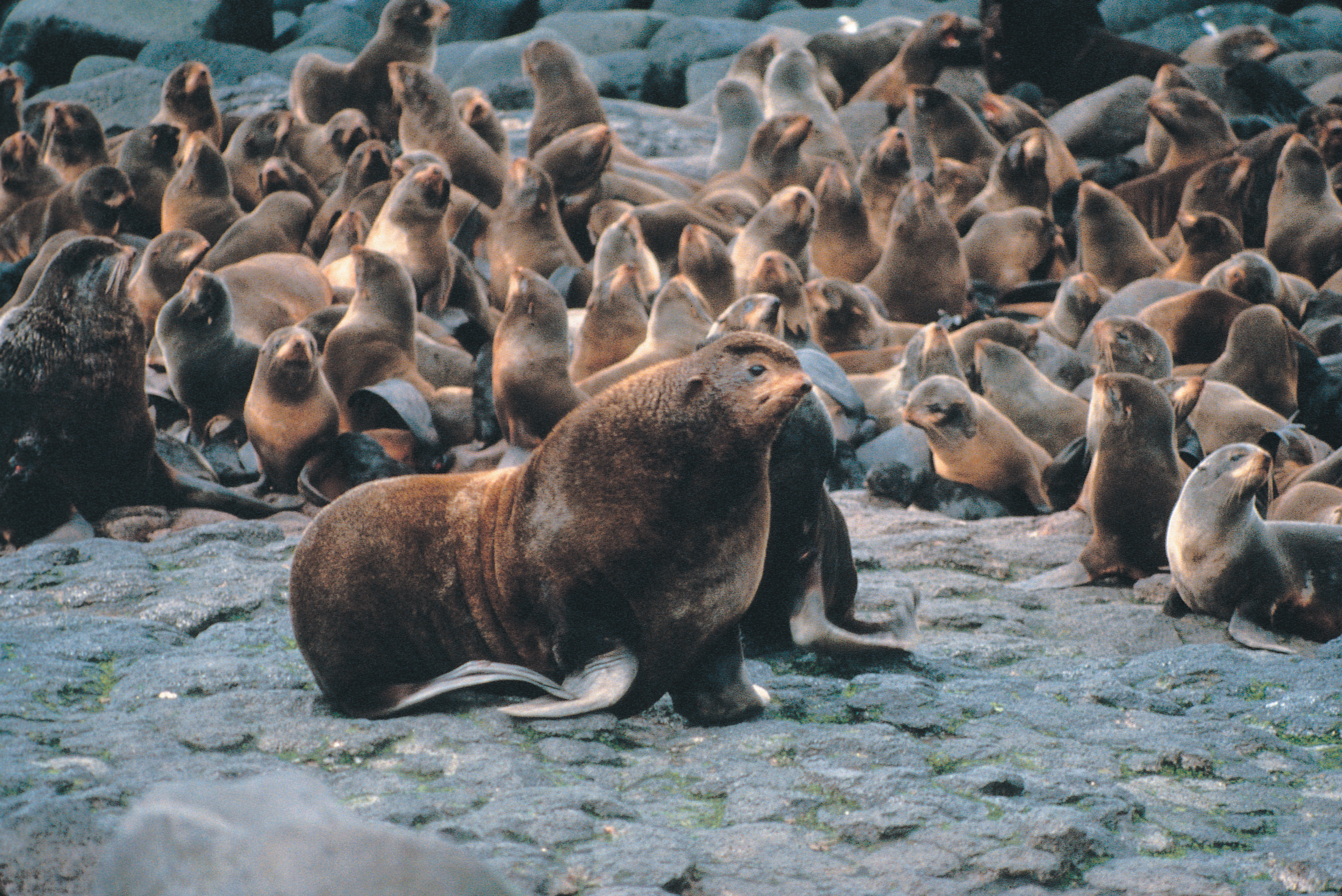|
Zalophus
''Zalophus'' is a genus of the family Otariidae (sea lions and fur seals) of the order Carnivora. Description The seals of the genus ''Zalophus'' present a striking sexual dimorphism, since the adult males have a pronounced sagittal crest, and weigh, in the Californian species, between 300 and 380 kg with 240 cm long, and the females 80 to 120 kg with between 180 and 200 cm. As with all ear seals, the males are significantly larger and heavier than the females. The males are dark brown in color, the females are lighter. In contrast to the other ear seals, the males do not have a clearly defined mane. In the Galapagos species the males weigh about 250 kg with a length of 250 to 270 cm, while the females weigh from 60 to 100 kg with a length of between 150 and 170 cm. They have a streamlined body, with a layer of fat under the skin, to provide warmth and buoyancy. The coat is brown. They have large eyes that help compensate for low light lev ... [...More Info...] [...Related Items...] OR: [Wikipedia] [Google] [Baidu] |
California Sea Lion
The California sea lion (''Zalophus californianus'') is a coastal eared seal native to western North America. It is one of six species of sea lions. Its natural habitat ranges from southeast Alaska to central Mexico, including the Gulf of California. California sea lions are Sexual dimorphism, sexually dimorphic; males are larger than females, and have a thicker neck, and a protruding sagittal crest. They mainly Hauling-out, haul out on sandy or rocky beaches, but they also frequent manmade environments such as marinas and Wharf, wharves. California sea lions feed on a number of species of fish and squid, and are preyed on by orcas and great white sharks. California sea lions have a Polygyny in animals, polygynous breeding pattern. From May to August, males establish territory (animal), territories and try to attract females with which to mate. Females are free to move in between territories, and are not coerced by males. Mothers nurse their pups in between foraging trips. Califo ... [...More Info...] [...Related Items...] OR: [Wikipedia] [Google] [Baidu] |
Galápagos Sea Lion
The Galápagos sea lion (''Zalophus wollebaeki'') is a species of sea lion that lives and breeds on the Galápagos Islands and, in smaller numbers, on Isla de la Plata (Ecuador). Being fairly social, they are often spotted sun-bathing on sandy shores or rock groups, or gliding through the surf. While they may seem like easy friends with their proximity to heavily populated areas, it is important to keep distance from these animals, as disruption may cause issues for them and for anyone who gets too close. They are the smallest sea lion species. Taxonomy This species was first described by E. Sivertsen in 1953. It has been considered a subspecies of '' Zalophus californianus'' (called ''Z. c. wollebaeki'') by many authors. But genetic data supports ''Z. wollebaeki'' as a separate species. The species belongs to the family Otariidae and genus ''Zalophus''. Physical characteristics Slightly smaller than their Californian relatives, Galápagos sea lions range from in le ... [...More Info...] [...Related Items...] OR: [Wikipedia] [Google] [Baidu] |
Zalophus
''Zalophus'' is a genus of the family Otariidae (sea lions and fur seals) of the order Carnivora. Description The seals of the genus ''Zalophus'' present a striking sexual dimorphism, since the adult males have a pronounced sagittal crest, and weigh, in the Californian species, between 300 and 380 kg with 240 cm long, and the females 80 to 120 kg with between 180 and 200 cm. As with all ear seals, the males are significantly larger and heavier than the females. The males are dark brown in color, the females are lighter. In contrast to the other ear seals, the males do not have a clearly defined mane. In the Galapagos species the males weigh about 250 kg with a length of 250 to 270 cm, while the females weigh from 60 to 100 kg with a length of between 150 and 170 cm. They have a streamlined body, with a layer of fat under the skin, to provide warmth and buoyancy. The coat is brown. They have large eyes that help compensate for low light lev ... [...More Info...] [...Related Items...] OR: [Wikipedia] [Google] [Baidu] |
Japanese Sea Lion
The Japanese sea lion (''Zalophus japonicus'') (, ) was an aquatic mammal that became extinct in the 1970s. It was considered to be a subspecies of the related California sea lion (''Z. californianus'') until 2003. They inhabited the western North Pacific and its marginal seas including the Sea of Okhotsk and the Sea of Japan, especially around the coastal areas of the Japanese Archipelago and the Korean Peninsula. They generally bred on sandy beaches which were open and flat, but sometimes in rocky areas. They were hunted commercially in the 1900s, leading to their extinction. Taxonomy Prior to 2003, it was considered to be a subspecies of California sea lion as ''Zalophus californianus japonicus''. However, it was subsequently reclassified as a separate species. DNA analysis in 2007 estimated that the divergence point between the two sea lions took place around 2 mya (unit), million years ago (mya) in the early Pleistocene. Several taxidermied specimens can be found in Japan a ... [...More Info...] [...Related Items...] OR: [Wikipedia] [Google] [Baidu] |
Sea Lion
Sea lions are pinnipeds characterized by external ear flaps, long foreflippers, the ability to walk on all fours, short and thick hair, and a big chest and belly. Together with the fur seals, they make up the family Otariidae, eared seals. The sea lions have six extant and one extinct species (the Japanese sea lion) in five genera. Their range extends from the subarctic to tropical waters of the global ocean in both the Northern and Southern Hemispheres, with the notable exception of the northern Atlantic Ocean. Sea lions have an average lifespan of 20–30 years. A male California sea lion weighs on average about and is about long, while the female sea lion weighs and is long. The largest sea lions are Steller's sea lions, which can weigh and grow to a length of . Sea lions consume large quantities of food at a time and are known to eat about 5–8% of their body weight (about ) at a single feeding. Sea lions can move around in water and at their fastest they ... [...More Info...] [...Related Items...] OR: [Wikipedia] [Google] [Baidu] |
Carnivoran Genera
Carnivora ( ) is an order of placental mammals specialized primarily in eating flesh, whose members are formally referred to as carnivorans. The order Carnivora is the sixth largest order of mammals, comprising at least 279 species. Carnivorans are found on every major landmass and in a variety of habitats, ranging from the cold polar regions of Earth to the hyper-arid region of the Sahara Desert and the open seas. Carnivorans exhibit a wide array of body plans, varying greatly in size and shape. Carnivora are divided into two suborders, the Feliformia, containing the true felids and several animals; and the Caniformia, containing the true canids and many animals. The feliforms include the Felidae, Viverridae, hyena, and mongoose families, the majority of which live only in the Old World; cats are the only exception, occurring in the Old World and the New World, entering the Americas via the Bering land bridge. The caniforms include the Caninae, Procyonidae, bears, mustelids, ... [...More Info...] [...Related Items...] OR: [Wikipedia] [Google] [Baidu] |
Carnivora
Carnivora ( ) is an order of placental mammals specialized primarily in eating flesh, whose members are formally referred to as carnivorans. The order Carnivora is the sixth largest order of mammals, comprising at least 279 species. Carnivorans are found on every major landmass and in a variety of habitats, ranging from the cold polar regions of Earth to the hyper-arid region of the Sahara Desert and the open seas. Carnivorans exhibit a wide array of body plans, varying greatly in size and shape. Carnivora are divided into two suborders, the Feliformia, containing the true felids and several animals; and the Caniformia, containing the true canids and many animals. The feliforms include the Felidae, Viverridae, hyena, and mongoose families, the majority of which live only in the Old World; cats are the only exception, occurring in the Old World and the New World, entering the Americas via the Bering land bridge. The caniforms include the Caninae, Procyonidae, bears, ... [...More Info...] [...Related Items...] OR: [Wikipedia] [Google] [Baidu] |
Mating
In biology, mating is the pairing of either opposite-sex or hermaphroditic organisms for the purposes of sexual reproduction. ''Fertilization'' is the fusion of two gametes. '' Copulation'' is the union of the sex organs of two sexually reproducing animals for insemination and subsequent internal fertilization. Mating may also lead to external fertilization, as seen in amphibians, fishes and plants. For most species, mating is between two individuals of opposite sexes. However, for some hermaphroditic species, copulation is not required because the parent organism is capable of self-fertilization (autogamy); for example, banana slugs. The term ''mating'' is also applied to related processes in bacteria, archaea and viruses. Mating in these cases involves the pairing of individuals, accompanied by the pairing of their homologous chromosomes and then exchange of genomic information leading to formation of recombinant progeny (see mating systems). Animals For animals ... [...More Info...] [...Related Items...] OR: [Wikipedia] [Google] [Baidu] |
Harem (zoology)
A harem is an animal group consisting of one or two males, a number of females, and their offspring. The dominant male drives off other males and maintains the unity of the group. If present, the second male is subservient to the dominant male. As juvenile males grow, they leave the group and roam as solitary individuals or join bachelor herds. Females in the group may be inter-related. The dominant male mates with the females as they become sexually active and drives off competitors, until he is displaced by another male. In some species, incoming males that achieve dominant status may commit infanticide. For the male, the primary benefit of the harem system is obtaining exclusive access to a group of mature females. The females benefit from being in a stable social group and the associated benefits of grooming, predator avoidance and cooperative defense of territory. The disadvantages for the male are the energetic costs of gaining or defending a harem which may leave him wi ... [...More Info...] [...Related Items...] OR: [Wikipedia] [Google] [Baidu] |
Arctocephalus
The genus ''Arctocephalus'' consists of the southern fur seals. ''Arctocephalus'' translates to "bear head." Taxonomy The number of species within the genus has been questioned, primarily based on limited molecular data. The issue is complicated because some of the species are able to produce fertile hybrids. A recent review recommended the retention of seven species, deprecating the New Zealand fur seals to a subspecies of the South American fur seal, while also questioning the status of the Guadalupe fur seal. Other recent studies have indicated the genus may be paraphyletic, and some taxonomic reshuffling was previously done to account for this; however, more recent studies support it being monophyletic In biological cladistics for the classification of organisms, monophyly is the condition of a taxonomic grouping being a clade – that is, a grouping of organisms which meets these criteria: # the grouping contains its own most recent co ..., with the alleged par ... [...More Info...] [...Related Items...] OR: [Wikipedia] [Google] [Baidu] |
Territory (animal)
In ethology, territory is the sociographical area that an animal consistently defends against conspecificity, conspecific competition (biology), competition (or, occasionally, against animals of other species) using agonistic behaviors or (less commonly) real physical aggression. Animals that actively defend territories in this way are referred to as being territorial or displaying territorialism. Territoriality is only shown by a minority of species. More commonly, an individual or a group of animals occupies an area that it habitually uses but does not necessarily defend; this is called its home range. The home ranges of different groups of animals often overlap, and in these overlap areas the groups tend to avoid each other rather than seeking to confront and expel each other. Within the home range there may be a ''core area'' that no other individual group uses, but, again, this is as a result of avoidance. Function The ultimate function of animals inhabiting and defendin ... [...More Info...] [...Related Items...] OR: [Wikipedia] [Google] [Baidu] |





